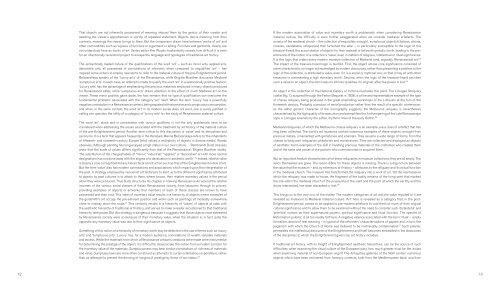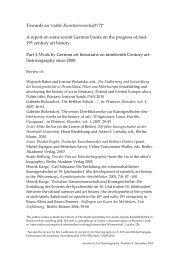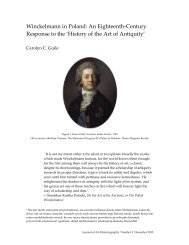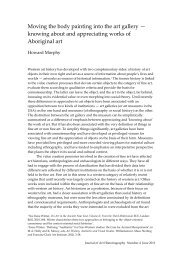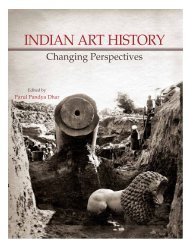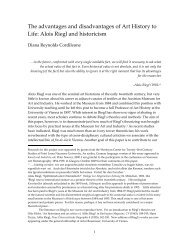Relics of Another Age: Art History, the - Journal of Art Historiography
Relics of Another Age: Art History, the - Journal of Art Historiography
Relics of Another Age: Art History, the - Journal of Art Historiography
You also want an ePaper? Increase the reach of your titles
YUMPU automatically turns print PDFs into web optimized ePapers that Google loves.
That objects are not inherently possessed <strong>of</strong> meaning imbued <strong>the</strong>m by <strong>the</strong> genius <strong>of</strong> <strong>the</strong>ir creator and<br />
awaiting <strong>the</strong> viewer’s apprehension is worthy <strong>of</strong> repeated statement. Objects derive meaning from <strong>the</strong>ir<br />
contexts, meanings <strong>the</strong> viewer brings to <strong>the</strong>m. But <strong>the</strong> comparison drawn here between ‘works <strong>of</strong> art’ and<br />
o<strong>the</strong>r commodities such as ‘a piece <strong>of</strong> furniture or a garment’ is telling. Furniture and garments, clearly, are<br />
not understood here as works <strong>of</strong> art. Series editor Kim Woods inadvertently reveals how difficult it is even<br />
for an intentionally revisionist project to escape <strong>the</strong> language and typologies <strong>of</strong> traditional art history.<br />
The semantically loaded nature <strong>of</strong> <strong>the</strong> qualifications <strong>of</strong> <strong>the</strong> word ‘art’ – such as minor arts, applied arts,<br />
decorative arts, all possessed <strong>of</strong> connotations <strong>of</strong> inferiority when compared to unqualified ‘art’ – has<br />
inspired some writers to employ new terms to refer to <strong>the</strong> material culture <strong>of</strong> <strong>the</strong> pre-Enlightenment period.<br />
Belozerskaya speaks <strong>of</strong> <strong>the</strong> ‘luxury arts’ <strong>of</strong> <strong>the</strong> Renaissance, while Brigitte Buettner discusses Medieval<br />
‘sumptuous arts’. In each case, an attempt is made to qualify <strong>the</strong> word ‘art’ in a semantically positive fashion.<br />
‘Luxury arts’ has <strong>the</strong> advantage <strong>of</strong> emphasising <strong>the</strong> precious materials employed in many objects produced<br />
for Renaissance elites, while ‘sumptuous arts’ draws attention to <strong>the</strong> effect <strong>of</strong> much Medieval art on <strong>the</strong><br />
viewer. These minor positive gains aside, <strong>the</strong> fact remains that no type <strong>of</strong> qualification can overcome <strong>the</strong><br />
fundamental problems associated with <strong>the</strong> category ‘art’ itself. When <strong>the</strong> term ‘luxury’ has a powerfully<br />
negative connotation in a Renaissance context, being equated with excessive and conspicuous consumption,<br />
and when, in <strong>the</strong> same context, <strong>the</strong> word ‘art’ in its modern sense does not exist, one is surely justified in<br />
calling into question <strong>the</strong> utility <strong>of</strong> a category <strong>of</strong> ‘luxury arts’ for <strong>the</strong> study <strong>of</strong> Renaissance material culture.<br />
The word ‘art’, alone and in combination with various qualifiers, is not <strong>the</strong> only problematic term to be<br />
considered when addressing <strong>the</strong> issues associated with <strong>the</strong> treatment by art history <strong>of</strong> <strong>the</strong> material culture<br />
<strong>of</strong> <strong>the</strong> pre-Enlightenment period. <strong>Ano<strong>the</strong>r</strong> term critical to this discussion is ‘value’ and its derivatives and<br />
synonyms. It is a term that appears frequently in <strong>the</strong> literature: Marina Belozerskaya refers to ‘<strong>the</strong> inhabitants<br />
<strong>of</strong> fifteenth- and sixteenth-century Europe [who] valued a multiplicity <strong>of</strong> objects in diverse media’; Woods<br />
observes, ‘Although painting has long enjoyed a high status in our own culture … Rembrandt Duits stresses<br />
anew that this scale <strong>of</strong> values differs significantly from that <strong>of</strong> <strong>the</strong> Renaissance’; Brigitte Buettner states,<br />
‘<strong>the</strong> substitution <strong>of</strong> <strong>the</strong> charged labels <strong>of</strong> “minor,” “industrial,” “applied,” or “decorative” art with more neutral<br />
designations has not done away with <strong>the</strong> stigma <strong>of</strong> a devaluation in aes<strong>the</strong>tic worth’. 20 Indeed, relative value<br />
is clearly a core concept behind any hierarchical construction such as that <strong>of</strong> <strong>the</strong> Enlightenment notion <strong>of</strong> art.<br />
But <strong>the</strong> term ‘value’ also has modern connotations and associations which impact upon <strong>the</strong> interpretation <strong>of</strong><br />
<strong>the</strong> past. A strategy employed by revisionist art historians to alert us to <strong>the</strong> different significance attributed<br />
to objects by past cultures is to attach to <strong>the</strong>m, where known, <strong>the</strong>ir relative monetary values in <strong>the</strong> period<br />
when <strong>the</strong>y were produced. Thus Duits structures his chapter in Viewing Renaissance <strong>Art</strong> around <strong>the</strong> relative<br />
incomes <strong>of</strong> <strong>the</strong> various social classes <strong>of</strong> Italian Renaissance society, from labourers through to princes,<br />
providing examples <strong>of</strong> objects or artworks that members <strong>of</strong> each <strong>of</strong> <strong>the</strong>se classes are known to have<br />
possessed and <strong>the</strong>ir cost. This index <strong>of</strong> monetary value results in a hierarchy <strong>of</strong> objects where examples <strong>of</strong><br />
<strong>the</strong> goldsmith’s art occupy <strong>the</strong> pre-eminent position and works such as paintings sit modestly somewhere<br />
close to midway down <strong>the</strong> scale. 21 This certainly results in a hierarchy <strong>of</strong> ‘values’ <strong>of</strong> objects at odds with<br />
<strong>the</strong> aes<strong>the</strong>tic hierarchy <strong>of</strong> traditional art history, and serves to make a reader accustomed to that traditional<br />
hierarchy take pause. But this strategy is dangerous because it suggests that those objects most esteemed<br />
by Renaissance society were so because <strong>of</strong> <strong>the</strong>ir monetary value, when <strong>the</strong> situation is, in fact, quite <strong>the</strong><br />
opposite: any monetary value was due to <strong>the</strong>ir significance as objects.<br />
Something <strong>of</strong> this notion <strong>of</strong> a hierarchy <strong>of</strong> monetary worth may be detected in <strong>the</strong> use <strong>of</strong> terms such as ‘luxury<br />
arts’ and ‘sumptuous arts’. ‘Luxury’ has, for a modern audience, connotations <strong>of</strong> wealth, valuable materials<br />
and excess. While <strong>the</strong> materials from which a Renaissance artisan’s creations were made were instrumental<br />
for determining <strong>the</strong> prestige <strong>of</strong> <strong>the</strong> object, it is difficult to disassociate this notion from a modern concern for<br />
<strong>the</strong> monetary value <strong>of</strong> <strong>the</strong> materials. Sumptuousness may bear similar connotations <strong>of</strong> richness <strong>of</strong> materials<br />
and value. Sumptuary laws are more <strong>of</strong>ten construed as attempts to curtail ostentatious expenditure, ra<strong>the</strong>r<br />
than as attempts to prevent <strong>the</strong> donning <strong>of</strong> insignia <strong>of</strong> prestige by those <strong>of</strong> low status. 22<br />
If <strong>the</strong> modern association <strong>of</strong> value and monetary worth is problematic when considering Renaissance<br />
material culture, <strong>the</strong> difficulty is even fur<strong>the</strong>r exaggerated when we consider medieval artefacts. The<br />
ornatus <strong>of</strong> <strong>the</strong> medieval church – <strong>the</strong> collection <strong>of</strong> exquisitely wrought, ‘sumptuous’ objects (chalices, ciboria,<br />
crosses, candelabra, reliquaries) that furnished <strong>the</strong> altar – is particularly susceptible to <strong>the</strong> logic <strong>of</strong> <strong>the</strong><br />
treasure-hoard, <strong>the</strong> accumulation <strong>of</strong> objects for <strong>the</strong>ir material or (at best) symbolic worth, leading to <strong>the</strong> preeminence<br />
<strong>of</strong> <strong>the</strong> notion <strong>of</strong> a collection’s ‘value’, even in matters <strong>of</strong> religious, intellectual or ritual significance.<br />
It is this logic that orders every modern museum collection <strong>of</strong> Medieval (and, arguably, Renaissance) art. 23<br />
The impact <strong>of</strong> <strong>the</strong> treasure-hoard logic is tw<strong>of</strong>old. First, <strong>the</strong> object whose core significance consisted <strong>of</strong><br />
some characteristic no longer acknowledged by modern discourses, ra<strong>the</strong>r than presenting a problem to <strong>the</strong><br />
logic <strong>of</strong> <strong>the</strong> collection, is attributed a value, even if it is a social or mythical one, so that it may sit with o<strong>the</strong>r<br />
treasures in commanding a high monetary worth. Second, when <strong>the</strong> logic <strong>of</strong> <strong>the</strong> treasure-hoard ascribes<br />
such a value to an object, <strong>the</strong> item loses its intrinsic qualities: its original, affective power is lost. 24<br />
An object in <strong>the</strong> collection <strong>of</strong> <strong>the</strong> National Gallery <strong>of</strong> Victoria illustrates this point. The Limoges Reliquary<br />
casket (fig. 1), acquired through <strong>the</strong> Felton Bequest in 1936, is a fine and representative example <strong>of</strong> <strong>the</strong> type<br />
<strong>of</strong> chasse reliquary being produced in <strong>the</strong> great enamelling workshops <strong>of</strong> <strong>the</strong> Limousin at <strong>the</strong> turn <strong>of</strong> <strong>the</strong><br />
thirteenth century. Probably a product <strong>of</strong> serial production ra<strong>the</strong>r than <strong>the</strong> result <strong>of</strong> a specific commission,<br />
as <strong>the</strong> ra<strong>the</strong>r generic character <strong>of</strong> <strong>the</strong> iconography suggests, <strong>the</strong> Melbourne reliquary is never<strong>the</strong>less<br />
characterised by <strong>the</strong> high quality <strong>of</strong> its execution and exemplifies <strong>the</strong> first tempering <strong>of</strong> <strong>the</strong> Late Romanesque<br />
style in Limoges enamels by <strong>the</strong> s<strong>of</strong>ter, rhythmic lines <strong>of</strong> <strong>the</strong> early Gothic. 25<br />
Medieval reliquaries, <strong>of</strong> which <strong>the</strong> Melbourne chasse reliquary is an example, are a class <strong>of</strong> artefact that has<br />
long been collected. The world’s art museums contain numerous examples <strong>of</strong> <strong>the</strong>se objects, wrought from<br />
precious metals, ornamented with gemstones and enamels. They assume a wide range <strong>of</strong> forms, from <strong>the</strong><br />
chasse to body-part reliquaries, philatories and monstrances. They are collected and displayed as objects<br />
<strong>of</strong> aes<strong>the</strong>tic merit, examples <strong>of</strong> <strong>the</strong> skill in handling precious materials <strong>of</strong> <strong>the</strong> craftsmen who created <strong>the</strong>m<br />
and <strong>of</strong> <strong>the</strong> taste and power <strong>of</strong> <strong>the</strong> patrons who commissioned or acquired <strong>the</strong>m.<br />
But an important feature characterises all <strong>of</strong> <strong>the</strong>se reliquaries in museum collections: <strong>the</strong>y are all empty. The<br />
relics <strong>the</strong>mselves are gone. The raison d’être for <strong>the</strong>se objects is missing. There is a disjuncture between<br />
<strong>the</strong> value that <strong>the</strong> museum – and, by extension, art history – attributes to <strong>the</strong> reliquary and its actual function<br />
in <strong>the</strong> medieval church. The museum has transformed <strong>the</strong> reliquary into a work <strong>of</strong> art. Yet <strong>the</strong> real treasure<br />
which <strong>the</strong> reliquary was made to house, <strong>the</strong> fragment <strong>of</strong> <strong>the</strong> bodily remains <strong>of</strong> <strong>the</strong> living saint that marked<br />
<strong>the</strong> site within <strong>the</strong> medieval church <strong>of</strong> <strong>the</strong> praesentia <strong>of</strong> <strong>the</strong> saint and <strong>the</strong> point at which <strong>the</strong> earthly and <strong>the</strong><br />
divine intersected, has been discarded or lost. 26<br />
This brings us to <strong>the</strong> very crux <strong>of</strong> <strong>the</strong> matter. The modern categories <strong>of</strong> art and <strong>the</strong> value imputed to it are<br />
revealed as irrelevant to Medieval material culture. ‘<strong>Art</strong>’ here is revealed as a category that, in <strong>the</strong> post-<br />
Enlightenment period, comes to be applied to pre-modern artefacts to void <strong>the</strong>m <strong>of</strong> much <strong>of</strong> <strong>the</strong>ir original<br />
cultural significance and to allow <strong>the</strong>m to be examined without <strong>the</strong> need to consider such ‘distasteful’ and<br />
‘primitive’ notions as <strong>the</strong>ir supernatural powers, spiritual significance and ritual function. The spectre <strong>of</strong><br />
Reformation polemic is all too readily felt here. A negative valence associated with <strong>the</strong> term ‘ritual’ – empty<br />
formalism, devoid <strong>of</strong> real meaning – is typical <strong>of</strong> <strong>the</strong> reformers’ characterisations <strong>of</strong> papism and, in turn, <strong>the</strong><br />
paganism with which <strong>the</strong> Church <strong>of</strong> Rome was believed to be irretrievably contaminated. 27 Such polemic<br />
permeates <strong>the</strong> intellectual discourse <strong>of</strong> <strong>the</strong> Enlightenment and itself becomes embedded in <strong>the</strong> discourses<br />
<strong>of</strong> <strong>the</strong> disciplines to which <strong>the</strong> Enlightenment gives rise, art history included.<br />
If traditional art history, with its freight <strong>of</strong> Enlightenment aes<strong>the</strong>tic hierarchies, can be <strong>the</strong> source <strong>of</strong> such<br />
difficulties when examining <strong>the</strong> visual culture <strong>of</strong> <strong>the</strong> European past, how much greater must be <strong>the</strong> issues<br />
when examining material <strong>of</strong> non-European origin? The Antiquities galleries <strong>of</strong> <strong>the</strong> NGV contain numerous<br />
objects which have been recovered from funerary contexts, both from <strong>the</strong> Mediterranean basin and from<br />
12 13


